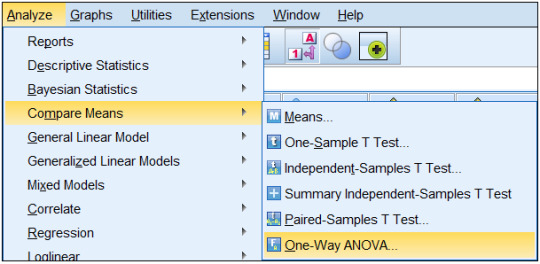Text
One-Way ANOVA
One-Way ANOVA ("analysis of variance") compares the means of two or more independent groups in order to determine whether there is statistical evidence that the associated population means are significantly different. One-Way ANOVA is a parametric test.This test is also known as:One-Factor ANOVAOne-Way Analysis of VarianceBetween Subjects ANOVAThe variables used in this test are known as:Dependent variableIndependent variable (also known as the grouping variable, or factor)This variable divides cases into two or more mutually exclusive levels, or groupsCommon UsesThe One-Way ANOVA is often used to analyze data from the following types of studies:Field studiesExperimentsQuasi-experimentsThe One-Way ANOVA is commonly used to test the following:Statistical differences among the means of two or more groupsStatistical differences among the means of two or more interventionsStatistical differences among the means of two or more change scoresNote: Both the One-Way ANOVA and the Independent Samples t-Test can compare the means for two groups. However, only the One-Way ANOVA can compare the means across three or more groups.Note: If the grouping variable has only two groups, then the results of a one-way ANOVA and the independent samples t-test will be equivalent. In fact, if you run both an independent samples t-test and a one-way ANOVA in this situation, you should be able to confirm that t2=F.Data RequirementsYour data must meet the following requirements:Dependent variable that is continuous (i.e., interval or ratio level)Independent variable that is categorical (i.e., two or more groups)Cases that have values on both the dependent and independent variablesIndependent samples/groups (i.e., independence of observations)There is no relationship between the subjects in each sample. This means that:subjects in the first group cannot also be in the second groupno subject in either group can influence subjects in the other groupno group can influence the other groupRandom sample of data from the populationNormal distribution (approximately) of the dependent variable for each group (i.e., for each level of the factor)Non-normal population distributions, especially those that are thick-tailed or heavily skewed, considerably reduce the power of the testAmong moderate or large samples, a violation of normality may yield fairly accurate p valuesHomogeneity of variances (i.e., variances approximately equal across groups)When this assumption is violated and the sample sizes differ among groups, the p-value for the overall F test is not trustworthy. These conditions warrant using alternative statistics that do not assume equal variances among populations, such as the Browne-Forsythe or Welch statistics (available via Options in the One-Way ANOVA dialog box).When this assumption is violated, regardless of whether the group sample sizes are fairly equal, the results may not be trustworthy for post hoc tests. When variances are unequal, post hoc tests that do not assume equal variances should be used (e.g., Dunnett’s C).No outliersNote: When the normality, homogeneity of variances, or outliers assumptions for One-Way ANOVA are not met, you may want to run the nonparametric Kruskal-Wallis test instead.Researchers often follow several rules of thumb for one-way ANOVA:Each group should have at least 6 subjects (ideally more; inferences for the population will be more tenuous with too few subjects)Balanced designs (i.e., the same number of subjects in each group) are ideal; extremely unbalanced designs increase the possibility that violating any of the requirements/assumptions will threaten the validity of the ANOVA F test.
Need help?
Please visit our website for more details, here is the link; www.onlinespss.com
or please feel free to email us;
#SPSSdataanalysis #datamining #dataanalysis #dataanalysisservices #dataanalysisservice #dataanalysisspss #statisticsservice #statisticaldataanalysis #statisticalanalysis #datacollection #statistcalconsulting #statisticalconsultingfirms #data #dataanalyticsspss #dataanalytics #datascience #bigdata #education #SPSSdataanalysis #SPSSdataanalysisservices #datacollection #datacollectionservices #bigdataanalytics#statswork #statisticalanalysishelp #statisticalanalyseshelp#spssproject #assignmenthelp #spsshelp #dataanalysis #spsshomeworkhelp #statistics #biostatistics #SPSSAssignmenthelp #SPSShomeworkhelp #SPSShelp #SPSSproject #SPSStutor #OnlineSPSS #SPSShelpUSA #SPSShelpUK #SPSSClasses #statisticsassignmenthelp #statisticshomeworkhelp #statisticstutor #statisticshelp #homeworkhelp #assignmenthelp #rlanguagehelp #rprogramminghelp #rassignmenthelp #rhomeworkhelp #myassignmenthelponline #domyspssassignment

1 note
·
View note
Text
Get Help with your Data Analysis Task

Statistical data analysis is the most crucial parts of every research. However, it is one of the hardest parts in research. The type of data analysis conducted mainly depends on the study’s hypotheses and the nature of research conducted. Most times researchers are often indecisive of whether a study is qualitative or quantitative. A qualitative research is the type of research that is conducted to explore underlying reasons, opinions and motivations. On the other hand, a quantitative research is the type of research that is conducted to solve a problem by generating numeric data. It is often used to quantify attitudes, ideas, behavior. It is for this distinctive difference between the two types of research that their analysis methods differ. Common quantitative data analysis techniques include , Anova test, t-tests, regression and correlation tests.
Freelance data analysis is an online platform available at our website where our clients get to choose and hire our data analyst. Additionally, clients are also able to consult and be advised accordingly in relation to the type of data analysis. Need help? Please visit our website for more details, here is the link;
www.onlinespss.com
or please feel free to email us; E: [email protected]
0 notes
Text
Analysing data using SPSS TYPES OF DATA: Nominal Data: These are data which classify or categorise some attribute they may be coded as numbers but the numbers has no realmeaning, its just a label they have no default or natural order. Examples:, town of residence, colour of car, male or female (this lat one is an example of a dichotomous variable, it can take two mutually exclusive values. Ordinal Data: These are data that can be put in an order, but don’t have a numerical meaning beyond the order. So for instance, the difference between 2 and 4 in the example of a Lickert scale below might no be the same as the difference between 2 and 5. Examples: Questionnaire responses coded: 1 = strongly disagree, 2 = disagree, 3 = indifferent, 4 = agree, 5 = strongly agree. Level of pain felt in joint rated on a scale from 0 (comfortable) to 10 (extremely painful). Interval Data: These are numerical data where the distances between numbers have meaning, but the zero has no real meaning. With interval data it is not meaningful to say than one measurement is twice another, and might not still be true if the units were changed. Example: Temperature measured in Centigrade, a cup of coffee at 80°c isn't twice as hot a one at 40°c. Ratio Data: These are numerical data where the distances between data and the zero point have real meaning. With such data it is meaningful to say that one value is twice as much as another, and this would still be true if the units were changed. Examples: Heights, Weights, Salaries, Ages. If someone is twice as heavy as someone else in pounds, this will still be true in kilograms. How to find out Data Analysis in SPSS Continue Reading; https://www.onlinespss.com/services/spss-analysis/ You can find more information on our website and it is FREE! Click here to visit our web page Please feel free to contact us if you need any further information. Email: [email protected] #SPSSdataanalysis #datamining #dataanalysis #dataanalysisservices #dataanalysisservice #dataanalysisspss #statisticsservice #statisticaldataanalysis #statisticalanalysis #datacollection #statistcalconsulting #statisticalconsultingfirms #data #dataanalyticsspss #dataanalytics #datascience #bigdata #education #SPSSdataanalysis #SPSSdataanalysisservices #datacollection #datacollectionservices #bigdataanalytics #statswork #statisticalanalysishelp #statisticalanalyseshelp #spssproject #assignmenthelp #spsshelp #dataanalysis #spsshomeworkhelp #statistics #biostatistics #SPSSAssignmenthelp #SPSShomeworkhelp #SPSShelp #SPSSproject #SPSStutor #OnlineSPSS #SPSShelpUSA #SPSShelpUK #SPSSClasses #statisticsassignmenthelp #statisticshomeworkhelp #statisticstutor #statisticshelp #homeworkhelp #assignmenthelp #rlanguagehelp #rprogramminghelp #rassignmenthelp #rhomeworkhelp #myassignmenthelponline #domyspssassignment

0 notes